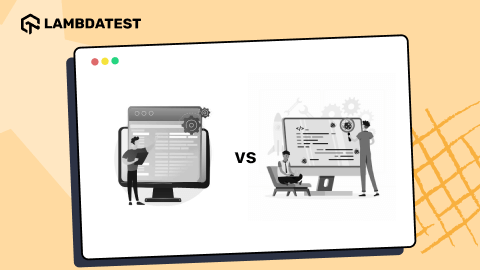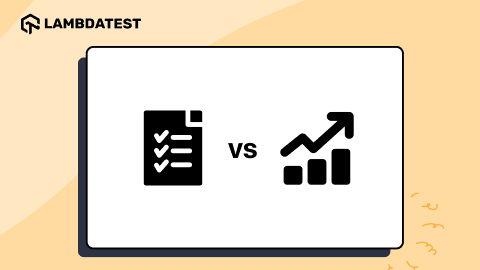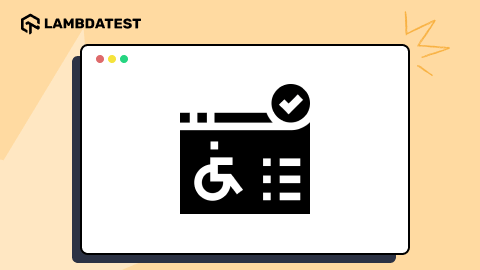How to Test a Mobile Website Using LambdaTest
Harshit Paul
Posted On: August 15, 2018
![]() 17156 Views
17156 Views
![]() 6 Min Read
6 Min Read
This article is a part of our Content Hub. For more in-depth resources, check out our content hub on Mobile Testing Tutorial.
By far, I am sure we have all witnessed an increase in the usage of mobile web browsers. According to StatCounter, there has been a noticeable incline in mobile and tablet users. By April 2014, 30% of web traffic was incoming through mobile users and the percentage has been elevating ever since.
In today’s competitive world where digital discovery is being more mobile centric, responsiveness comes as a requisite.
InVision quoted in one of their blog:
”Responsive design is no longer a luxury, but a necessity.”
With great audience comes great responsibility, this is true when we talk about quality assurance. Although mobile website testing is not a new topic, and you will find it as a staple of all QA checklists.
Wondering why?
- The bounce back rate of users is so elevated, you need an extra edge to your website for attracting more publicity and traffic towards it. RWD (Responsive Web Design) plays an indispensable role in it.
RWD – Responsive Web Design
A method of allowing your web pages to render through multiple devices or screen sizes without compromising the overall functionality. Devices could be a tablet, desktop, notebook or a smartphone. LambdaTest as a cross browser testing tool provides you an effective way of testing responsiveness of any website through various screen sizes.
- With inclining numbers of users on mobile users, one should be certain about delivering a positive UX experience through their mobile website. By delivering a mobile-friendly website you are aiming for:
- Exceeding search visibility
- Enhancing your brand value
- Enhancing User Experience as well as User Interface
- Elevation in lead nurturing
- On April 21, 2015, Google revolutionized SEO, by releasing a new mobile-friendly ranking algorithm. This algorithm gave preferences to mobile-optimized websites and came to known by many names such as Mobilegeddon, mobocalypse, mobilepocalyse. So if your website is not providing a quality mobile UX, then brace yourself for the fall in SERPs.
- On November 04, 2016, Google Webmaster posted came out with the concept of Mobile-first Indexing. Here, they stated:
Although our search index will continue to be a single index of websites and apps, our algorithms will eventually primarily use the mobile version of a site’s content to rank pages from that site, to understand structured data, and to show snippets from those pages in our results.
Getting started with Mobile Website Testing
Here is what you need to consider:
- Whether the website is looking impressive on every device.
- Ofcourse you need to check if there are any bugs existing in it.
- Is the website loading pages at an efficient speed.
Remember, speed is the key! If users won’t get that from your website then it won’t take them long to rush to your competitors
Validate your HTML and CSS issues with the help of Chrome Developer tools.
Cross Browser Compatibility – Flex, JavaScript, Applets, AJAX requests, Flash and many more client side components may behave differently on different web browsers with respect to their rendering engines. The process of testing whether website works consistently without any dependencies in feature delivery on various browsers through different OS is termed as Cross Browser Testing. Follow our blog on performing cross browser testing through LambdaTest.
Device Testing Labs/Clouds – These labs are a collection of real mobile devices, providing you a diverse mobile device testing experience. Once you test on real devices then you know for certain that your product is working as intended. However, maintaining such a library of mobile devices requires a heavy investment. For Instance, AWS Device Farm is offering 3 levels of pricing:
Start your real device farm testing today.
- $0.17 per device minute, with first 1,000 minutes free.
- Unlimited testing, starting from $250/month.
- Private devices (test on dedicated devices deployed exclusively for your account), starting from $200/month.
You may refer to this blog to know more about Device Testing Clouds.
What if you are not interested in paid options? Well, then it is time for you to turn from Device Testing Labs to Emulators and Simulators.
Android Emulator and iOS Simulator – They include default web browsers for figuring a valuable approximation regarding your website’s performance and appearance. You can’t have exact statistics related to page loading time or performance under real network scenario. Other than that they are a pretty viable to mobile testing. You can perform both Mobile Emulator Testing and Mobile Simulator Testing for free at LambdaTest without being hassled by the thought of setting up VM’s or worrying about licences. You can also go for responsive design checker such as LT Browser to check mobile view of website
In this detailed walkthrough of LT Browser tutorial video, we will help you get started with LT Browser.
At the end, it is all about SPEED!
On July 09, 2018, Google Webmaster updated the mobile search ranking using page loading speed. They stated:
The “Speed Update,” as we’re calling it, will only affect pages that deliver the slowest experience to users and will only affect a small percentage of queries. It applies the same standard to all pages, regardless of the technology used to build the page. The intent of the search query is still a very strong signal, so a slow page may still rank highly if it has great, relevant content.
Well if you aim to increase the responsive of your website, the page loading time is bound to increase as well. Because of the multiplication of assets included to facilitate a better UI and UX. How to cope up with them?
RESS – Responsive Web Design + Server Side Components
merges Server Side Components with the Responsive web layouts. This method is not intended to focus on a full page optimization, it dynamically loads the content in accordance to the specific device on which the website is being rendered upon. So if you are using a mobile phone with smaller screen resolution, then you don’t need a full size desktop image where you have to scroll your way to the desired content.
Prioritize on eradicating knows issues to ease user convenience. Also, make sure to Regression test after every deployment. Follow our blog on Regression Testing strategies of mobile web pages.
Finding issues and bug logging is tedious but crucial. LambdaTest being cloud driven product provides you integrations with multiple platforms for hastening release process:
- ASANA
- SLACK
- JIRA
- TRELLO
- GITHUB
- VSTS
- GITLAB
- BITBUCKET
- LambdaTest WordPress Plugin : This plugin allows user to take screenshots of web pages. User can then post those screenshots directly from WordPress platform through a single click
That is all!
That just about sums up the basics of mobile website testing. Now you know why we should test mobile websites and how? What you also know is that LambdaTest is an all-in-one stop for it. Become an insider and test for yourself. Happy Testing!
On a side note you can refer to our article on how to check screen resolution on Android if you wish to debug screen resolution issue.
Got Questions? Drop them on LambdaTest Community. Visit now













